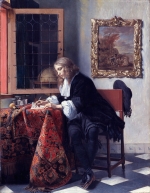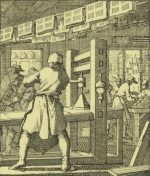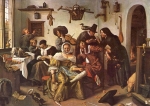Visited by Zacharias Conrad von Uffenbach: "more of ingenuity than foundation"
On his way to England in 1710, German scholar Zacharias von Uffenbach (1683–1734) (right; click to enlarge) visited Leeuwenhoek with at least his brother Johann Friedrich and perhaps some others. Decades after he returned from his journey, Uffenbach's travelogue was published in several volumes. The passage below concerns his visit to Leeuwenhoek. Dobell has a negative view of Uffenbach:
... the fatuous comments of this complacent German diarist, who was so satisfied of his own superiority that he would be horrified if he could hear that his condescending notes on our poor Dutch draper are now the chief thing of interest in his tedious memoirs.
Nevertheless, Leeuwenhoek spent several hours with the brothers. The visit began with Maria van Leeuwenhoek noting that visitors like Uffenbach often ridiculed her father, which Uffenbach did, and ended with Maria and her father imploring the brothers not to tell anyone how much time Leeuwenhoek had given them. Uffenbach verified on his own that "many foreigners had waited on him in vain, that he would see no one, still less show people anything." Why Uffenbach?
Uffenbach's Travels, 1753, v III pp 349-360
It was translated and lightly edited by Dobell for his Little Animals (pp 63-69) and further edited by me. The italics are Uffenbach's Latin; the boldface is my emphasis. Leeuwenhoek's daughter Maria received them, probably in the front room. While they waited, she chatted about her father.
On the 4th December, we went in the morning to see the famous observator microscopicus, Leeuwenhoek, by whom ... we were most courteously received. The only daughter that he has, a person of about forty, led us first into an antechamber, and told us that her father, though he had discovered many new things with his microscopia in recent years, did not wish to publish any more of his observations during his lifetime, because of the affronts he had suffered, presumably in the writings of others; for he has now and then been ridiculed for the odd views expressed in his own writings, and has been accused of seeing more with his imagination than with his magnifying glasses.
Then Leeuwenhoek came into the room. If he was having trouble with his feet, perhaps he used a cane or shuffled.
Mr. Leeuwenhoek is a man of seventy-eight, but still hale and hearty, save that he cannot much use his feet. We were surprised to find him not at all shaky, and he still has almost incomparable eyesight, though he taxes his eyes greatly with his observations. He showed us the following experiments:
First, the circulation of the blood, very fine and clear, in the tail of a quite little flounder (which is one of the greatest delicacies among sea-fish). He was not only of opinion that where the blood runs upwards, these are the arteries, and where it runs downwards, the veiiae (of which I justly doubted whether such a sweeping assumption were allowable ?), but also he maintained that it is the venae and not the arteriae which pulsate. He also insisted that he could see with the naked eye that the pulse at the wrist beats downwards rather than upwards. Methinks, however, that herein Mr. Leeuwenhoek does but show his ignorance of anatomy; for the structure of the arteries sufficiently proves that the valvulae in them undoubtedly cause the pulse-beat, whereas the blood merely flows along and through the venae, which have no valvulae. Besides, it is surely impossible to distinguish whether the pulse at the wrist beats downwards or upwards? But this by the way.
Mr. Leeuwenhoek then cut off with a knife a small bit from a mussel, such as they are here wont to eat, and showed us that all its parts were in a continuous motion; just as a snake apparently continues to move itself for a long time when freshly hacked to pieces with a switch. In both cases this is due to the vital spirits, which seek to escape, and so bring about the movements.
Reading passages like this, it was easy for Dobell to ridicule Uffenbach: "his mistakes are too evident to comment".
Afterwards Mr. Leeuwenhoek cut a mussel in two through the middle, in order to show us how the eggs and young mussels are generated. He also showed us certain black dots, which he maintained were young mussels in their black shells; but we couldn't take them for such, being unable to distinguish them. He also cut the gut of a mussel in two, and showed us, by means of his microscopium, a great mass of sand in it, which the mussels presumably take in with the slime in which they live. Mr. Leeuwenhoek considered, and not unjustly, that this sand serves for the formation of the shells of their young ones, just as hens and other birds readily eat sand and lime for the sake of their egg-shells.
He wished also to show us the circulation of the blood in an eel, only the creature was too big and black. Mr. Leeuwenhoek makes this experiment with an instrument which ... is simple, large, and not at all convenient. The one made by Mez in Amsterdam, with a camera obscura, is better; with this one you are dazzled by the light and the glass. ...
He must refer to Leeuwenhoek's eel viewer (aalkijker) (right; click to enlarge). Stuffing a half-dead eel head first into the tube positioned the eel's almost transparent tail in front of the lens. With some patience and probably by adjusting the tail with a finger, the viewer could see the sluggish movement of the blood cells through the capillaries connecting the eel's arteries and veins. By this time, Leeuwenhoek had also developed a fish viewer (Van Seters' term: viskijker), which Uffenbach included a sketch of. See Fish viewers under Learn more below.
Mr. Leeuwenhoek showed us the circulation of the blood very well with this machine, though it was somewhat troublesome to manipulate, and would be even worse for making observations lasting over a long time, because you have to put the side of the microscopium, where the lens is, against your forehead, and look upwards through the tiny glass; which, after some time, would become tiresome.
Mr. Leeuwenhoek afterwards fetched some cases, in each of which were two microscopia ... likewise of quite a simple structure. ... Each of these microscopia had a particular curiosity stuck before it; but we saw the following:
First, in tubulo capillari, upwards of thirty small young oysters in spiritu vini. These could be seen quite clearly, and had the perfect form and structure of old and big oysters. ... We inquired how he introduced these young oysters into his capillary tubes, which he explained in the following fashion:
He cuts off the gut of an oyster, takes some of the stuff that is in it on a pen-knife, and smears it on his thumb-nail; he then pours a drop of spirits of wine upon it, and applies the capillary tube thereto, whereupon the spirit runs up the tube of itself, through the pressure of the air, and takes the little oysters along with it, they being commonly present in the substance that is in the beard or the gut of the old oysters. He uses spirit for this purpose in order that they may not so easily become foul, which, being fish, they only too readily do, as happened indeed formerly with him, when he used only water. This experiment is one of the finest and most curious that we saw at Mr. Leeuwenhoek's.
These cases, as Dobell notes, were the ones Leeuwenhoek bequeathed in a black lacquer cabinet to the Royal Society. Uffenbach's description is the most detailed by anyone other than Leeuwenhoek of his working methods. The front room must have had a table for Leeuwenhoek to set up his demonstrations.
He showed us further a "maggot", as they are called, supposed to grow in the pori of the nose. ...
Through another microscopium he showed us a sand-grain, which looked like the finest crystal with facettes. ...
In another microscopium he had, on a bit of glass, a particle of gold, which he had previously dissolved in aqua regia and then precipitated: this appeared just like a little gold tree, and exceeding pretty. ...
Next, Mr. Leeuwenhoek showed us, through another microscopium, the scale of a fish, whose structure was certainly wonderful. ...
Why was Leeuwenhoek spending so much time with one group of visitors? Exactly one week earlier, also a Tuesday, John Farrington had visited without receiving such attention. Perhaps Leeuwenhoek found Uffenbach more congenial because as his next specimen, he used his own skin. To him, what he scraped off his arm were scales. To Uffenbach, they were dander.
At this point Mr. Leeuwenhoek remarked that he must show us that men also have scales. Accordingly, he took a pen-knife, and scratched his arm several times; then took a glass tube and with it scraped several times the place that he had scratched. He then let us look at this tube through his microscopium, whereupon many little particles, like scales, were visible lying upon it.
These the good man takes to be scales, which a human being is provided with in order that the extremities of the nerves may not be injured, as also to prevent his sensations being too strong; for if the nerves were not so guarded, he would be unable to stand pain, or irritation, nor could he do any work. It is surely quite sufficient, however, that man is clothed with several skins, as is known from anatomy, and he has no need of scales like a fish: and what the good Mr. Leeuwenhoek takes for scales are really only the particles, or scurf, from the outermost skin, which are commonly present, especially in persons of a dry habit, and particularly on the head, and which are cast off from the cuticula as it dries up and peels off under the influence of the external air, but chiefly through the internal heat of the body, though it always forms anew underneath.
Mr. Leeuwenhoek showed us further the eye of a fly, which appeared very remarkable under the microscopium, and had the appearance of veritable hexagona lying alongside one another; which Mr. Leeuwenhoek considers actually are eyes, and consequently makes flies into something better than so many Arguses; for he is of opinion that a fly, according to his view, has more than a hundred, nay, more than a thousand, eyes; which is only one of this good man's extraordinary notions, which seem wont to have more of ingenuity than foundation.
As Maria had predicted when Uffenbach first arrived: "the affronts ... now and then been ridiculed ... accused of seeing more with his imagination than with his magnifying glasses".
Further, he showed us the wing of a fly, which also appeared very wonderful. ... The sting of a fly appeared also very singular. ...
Finally, Mr. Leeuwenhoek showed us his cabinet, in which he had at least a dozen little lacquered boxes, and in these quite a hundred and fifty of the little cases before mentioned, in each of which there lay two microscopes of the small sort. As we marvelled at this large store, we asked him whether he never sold any? as we would gladly have possessed ourselves of some: but he said no, he would sell none in his lifetime.
The cabinet, probably a beautiful piece of furniture that impressed visitors, could also be locked to keep them out. As had visitors for the past four decades, Uffenbach remarked on Leeuwenhoek's secrecy. Leeuwenhoek in fact told them quite a bit. Their discussion about whether Leeuwenhoek ground his lenses from chunks of glass or blew them at the end of a glass tube omits the third method: forming a drop at the end of a glass rod.
He was also very secret about his work, and how he did it: but we drew one thing and another out of him with all manner of questions. Thus, when we asked him whether all these microscopia were identical? he said they were all ground in the same grinding-cup, but nevertheless there was a difference between the various lenses, and as regards those ground last in any cup, indeed, a great difference.
When we further inquired of Mr. Leeuwenhoek whether he ground all his lenses, and did not blow any? he denied this, but displayed great contempt for the blown glasses. He pointed out to us how thin his microscopia were, compared with others, and how close together the laminae were between which the lens lay, so that no spherical glass could be thus mounted; all his lenses being ground, contrariwise, convex on both sides.
He also had some microscopia with double glasses, which, though they were double, and the lenses separated inside at their proper distance, presumably by another lamina, were nevertheless not much thicker than the simple ones. Notwithstanding that these are pretty troublesome to make, they yet are not much better than the simple ones, excepting that they magnify a little more; but only a little, as Mr. Leeuwenhoek himself confessed.
As regards the blown glasses, Mr. Leeuwenhoek assured us that he had succeeded, after ten years' speculation, in learning how to blow a serviceable kind of glasses which were not round. My brother was unwilling to believe this, but took it for a Dutch joke; since it is impossible, by blowing, to form anything but a sphere, or rounded end.
It is not clear what Uffenbach meant by this microscope with double glasses. Perhaps it was another attempt by Leeuwenhoek to develop the potential of his tiny lenses.
By Dutch joke, Uffenbach meant a misleading distraction. It is, in fact, easier to form a convex lens at the end of a glass bulb than it is to form a sphere. The photograph on the right shows a round, symmetrical mound at the end of a glass tube. Forming it automatically forms a similarly shaped mound on the inside of the tube at the same spot. Breaking away all but those two mounds leaves a convex lens. The problem is making it as small as Leeuwenhoek needed, less than 3 mm.
Yet one cannot sufficiently marvel at Mr. Leeuwenhoek's great diligence and industry, both in the making of observations and in the grinding of lenses, as also in the manufacture of the mechanical parts for his microscopia; albeit the latter are simple, and badly worked, and for the most part roughly fashioned, even the silver not being filed smooth in a single one of them.
We much wanted to ask him why he made so many microscopia, though he would not sell any; but we feared we might get only a Dutch answer. Presumably jealousy, lest anybody should get hold of microscopes of his pattern, during his lifetime, is chiefly at the bottom of this; but there is also some self-interest, in that his daughter will one day be able to sell them so much dearer, if they cannot be got during his own lifetime.
As we were going, both this extraordinary man and his daughter earnestly intreated us to tell no one that we had been to see him, or seen anything there; for the reason that he is old, and tired of being pestered, especially by people who are not true lovers of learning. We were told not only in Delft, but also by many foreigners who had waited upon him in vain, that he would see no one, still less show people anything: and we were therefore greatly rejoiced that we saw so many curious things at the house of this extraordinary old man.















